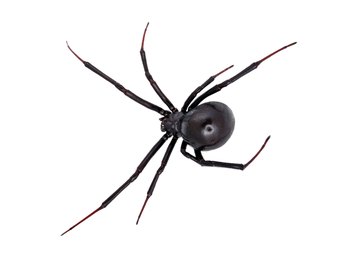
There are more than 500 different spider species in Illinois, but fortunately only a few of them are frequently found indoors. Most spiders in Illinois are not poisonous, but two species to stay away from are the brown recluse spider and the black widow spider. A bite from these spiders can be dangerous, making spider identification in Illinois important.
Black Widow Spider
Of all the black spiders in Illinois you may come across, the black widow spider (Latrodectus spp) is the most poisonous. You can identify a black widow spider by its black, shiny topside and the distinct red hourglass shape on its underside. Sometimes, it also has a row of red spots along the center of its abdomen.
While it's not an aggressive spider by nature, a female black widow may bite if her web is under threat, in order to defend her eggs. Typically, a black widow spider lives in tree stumps, under rocks and in garages, and is attracted to man-made items like trash cans, gardening tools and lawn furniture.
Brown Recluse Spider
The brown recluse spider (Loxosceles reclusa) has light brown legs that are very long in proportion to its brown, tan or orange body. Sometimes, but not always, it has a violin-shaped marking on its back. An unusual feature about the brown recluse spider is its eyes: Most spiders have eight eyes but brown recluse spiders have six eyes, arranged in three pairs.
The brown recluse spider lives up to its name, preferring to live in low-traffic places like dark basements and attics. It tends to hide during the day and venture out to hunt at night. A brown recluse spider is most likely to bite if it feels trapped.
House Spiders in Illinois
While most Illinois spiders prefer to stay outdoors, some favor an indoor life. Common house spiders in Illinois are cellar spiders (Pholcidae), cobweb spiders (Theridiidae) and sac spiders (Miturgidae and Clubionidae).
You might know cellar spiders as "daddy-longlegs," so-called because of their long, spindly legs. They have tiny bodies (not more than 1/4 inch long) and can be found – if you can spot them at all – hanging upside down in sheet-like or irregularly-shaped webs in corners of a room.
Cobweb spiders have bulbous abdomens, small heads and may be brown or black in color, with a range of markings and patterns. They hang in irregularly shaped webs, typically woven near the floor in moist indoor spaces such as basements. The black widow spider is actually a type of cobweb spider, but most cobweb spiders found in homes are not dangerous.
Sac spiders are small to medium-sized spiders that make 1 inch tube-shaped webs. The most common indoor sac spiders are the yellow sac spiders (Chiracanthium inclusum and C. mildei). They may be very small, but they are extremely nimble and hard working, spinning webs that stretch from floor to ceiling.
References
About the Author
Claire is a writer and editor with 18 years' experience. She writes about science and health for a range of digital publications, including Reader's Digest, HealthCentral, Vice and Zocdoc.
Photo Credits
Vukasin Mitic/iStock/Getty Images
